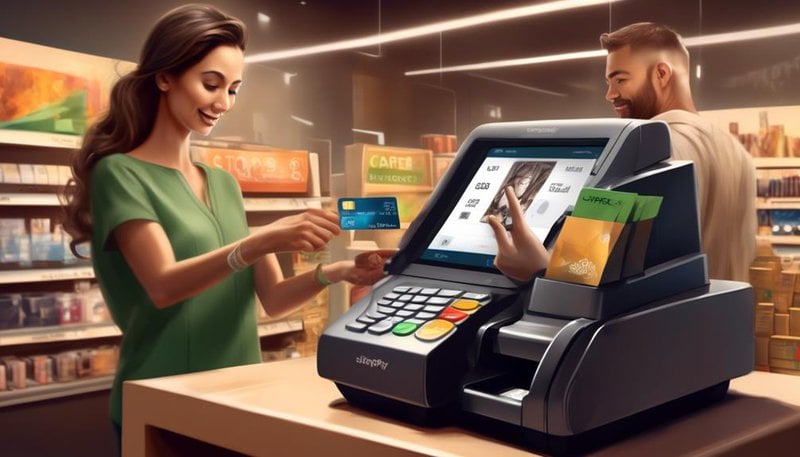How to Use Shopify's Point of Sale (POS) System

Shopify's Point of Sale (POS) system is a powerful tool that streamlines your sales process. It boosts efficiency and increases revenue by seamlessly managing inventory, accepting payments, and tracking sales in real-time. The system also integrates online and offline sales channels for a holistic view of your business.
Setting up Your Shopify POS Account
To set up your Shopify POS account, follow these step-by-step instructions for a seamless process.
- Make sure you have a Shopify account. If you don't, sign up for one on the Shopify website.
- Once you have an account, go to the Shopify Admin page and click on the 'Apps' tab.
- In the search bar, type 'Shopify POS' and click on the app.
- Install it and select 'Start Free Trial' to begin.
Next, choose your preferred POS system features.
- Shopify POS offers a range of features, including inventory management, customer profiles, and payment options.
- Customize your settings according to your business needs.
After that, set up your hardware.
- Connect your POS system to your device, such as an iPad or Android tablet, using the appropriate cables.
- If you want to accept card payments, you'll need a card reader as well.
Finally, test your setup by making a test sale and processing payment.
- Ensure everything is functioning properly before you start using your Shopify POS account for real transactions.
Adding and Managing Products in Your POS System
To add and manage products in your POS system, follow these simple steps for a streamlined process. Effective inventory management and product categorization are crucial for a successful POS system. Here's how you can do it:
- Log in to your Shopify POS account and click on the 'Products' tab.
- Select 'Add product' to create a new product listing.
- Fill in the required information such as product name, description, price, and SKU (Stock Keeping Unit).
- Assign the product to a category by selecting an existing one or creating a new category.
- Add product variants, such as different sizes or colors, if applicable.
- Upload clear and attractive product images.
- Set stock levels and enable inventory tracking to ensure accurate stock counts.
- Specify product tags to improve searchability and organization.
- Save the changes and your product will be added to your POS system.
To manage your products, you can easily update details, adjust prices, or track inventory levels from the 'Products' tab. With Shopify's POS system, you have the freedom to streamline your inventory management and product categorization, making it easier to sell and track your products.
Customizing Your POS System for Your Business
Customize your POS system to meet the unique needs of your business by following these simple steps.
Customizing POS designs and optimizing the checkout process can greatly improve the efficiency and effectiveness of your sales transactions. Here's how you can do it:
- Start by accessing your Shopify admin dashboard and go to the 'Settings' tab.
- From the 'Settings' menu, select 'Point of Sale' and then click on 'Customize POS'.
- Here, you can choose from a range of pre-designed templates or create a custom design for your POS system.
- Customize the layout, colors, and fonts to match your brand's aesthetic and create a seamless experience for your customers.
- Don't forget to add your logo and brand imagery to further personalize the system.
- Next, optimize the checkout process by setting up your preferred payment methods, such as credit card, cash, or mobile payment options.
- You can also enable features like automatic email receipts or discounts for specific products or customer groups.
- Finally, test your customized POS system to ensure everything is functioning smoothly.
Accepting Payments With Shopify's POS System
Now let's explore how you can seamlessly accept payments with Shopify's POS system. With the rise in popularity of mobile payments and contactless transactions, it's important to have a flexible and convenient payment solution for your customers. Shopify's POS system allows you to accept various payment methods, giving your customers the freedom to pay the way they prefer.
To accept payments with Shopify's POS system, follow these steps:
- Choose your payment method: Shopify's POS system supports a wide range of payment options, including credit cards, debit cards, mobile wallets, and even cash. Select the payment methods that best suit your business and customer preferences.
- Set up your hardware: Connect your payment hardware, such as card readers or contactless payment devices, to your Shopify POS system. This will enable you to securely process payments from your customers.
- Enter the payment details: When your customer is ready to make a purchase, simply enter the payment details into the Shopify POS system. This can be done manually or by swiping or tapping the customer's card or mobile device.
- Process the payment: After entering the payment details, the Shopify POS system will process the transaction securely and quickly. Your customer will receive a receipt, and the payment will be recorded in your Shopify dashboard.
- Track your payments: With Shopify's reporting and analytics tools, you can easily track and analyze your payment data. This will help you gain insights into your sales performance and make informed business decisions.
Managing Inventory and Tracking Sales in Real-Time
Now that you have set up your Shopify POS system and are ready to start selling, it's important to understand how to manage your inventory and track sales in real-time.
With Shopify's POS system, you can easily keep track of your inventory levels and make sure you never run out of stock.
Additionally, you can monitor your sales performance in real-time, allowing you to make informed business decisions and optimize your product offerings.
Real-Time Inventory Tracking
To effectively manage your inventory and track sales in real-time, Shopify's Point of Sale (POS) system provides an efficient solution. With real-time inventory tracking, you can easily keep track of your stock levels and make informed decisions about restocking.
Here's how it works:
- Centralized inventory management: When you make a sale in your physical store or online, the inventory is automatically updated across all your sales channels. This ensures that you always have accurate stock information.
- Low stock alerts: The POS system can notify you when a product is running low, allowing you to reorder before it goes out of stock. This helps you maintain a healthy inventory level and avoid lost sales.
- Sales analytics: By tracking sales in real-time, you can gain valuable insights into your best-selling products and identify trends. This information can guide your purchasing decisions and help optimize your inventory.
With Shopify's real-time inventory tracking, you have the freedom to focus on growing your business without the worry of stock control.
Sales Performance Monitoring
To effectively monitor your sales performance and manage your inventory in real-time, Shopify's Point of Sale (POS) system offers a seamless solution. With its built-in sales forecasting and sales analysis features, you can stay on top of your business and make informed decisions.
Here's how you can use the system to monitor your sales performance:
- Access the sales analytics dashboard: From your Shopify admin, navigate to the Analytics section and click on the Sales tab. Here, you can view key metrics like total sales, average order value, and top-selling products.
- Generate sales reports: Use the reporting feature to generate detailed sales reports based on custom time periods, channels, or products. These reports can provide valuable insights into your sales performance and help you identify trends and opportunities.
- Set sales goals: By setting sales goals within the POS system, you can track your progress and motivate your team to achieve targets.
With Shopify's POS system, you have the tools you need to monitor your sales performance and make data-driven decisions to grow your business.
Utilizing Customer Data and Analytics for Growth
To utilize customer data and analytics for growth, you need to adopt data-driven growth strategies and leverage analytics to make informed decisions.
Start by collecting and analyzing customer data from your POS system, such as purchase history and customer preferences.
Use this information to identify trends, understand customer behavior, and personalize your marketing campaigns.
Data-Driven Growth Strategies
Are you looking to grow your business using data-driven strategies? Utilizing customer data and analytics can be a powerful tool for driving growth and increasing revenue. By harnessing the power of data, you can better understand your customers, target your marketing efforts, and make informed business decisions. One effective data-driven growth strategy is customer segmentation, which involves dividing your customer base into distinct groups based on characteristics such as demographics, purchasing behavior, or preferences. This allows you to tailor your marketing messages and offers to specific segments, improving the effectiveness of your campaigns and increasing customer engagement. The table below provides a visual representation of how customer segmentation can be used to drive growth:
| Segment | Characteristics | Marketing Strategy |
|---|---|---|
| Segment A | High-income customers | Targeted email campaigns promoting premium products |
| Segment B | Young professionals | Social media ads highlighting convenience and affordability |
| Segment C | Families with children | In-store promotions and loyalty programs |
Leveraging Analytics for Success
Leveraging the power of customer data and analytics is essential for driving growth and achieving success in your business.
One way to effectively utilize customer data is through customer segmentation. This involves gaining a better understanding of your target audience and tailoring your marketing efforts to their specific needs and preferences.
To begin, start collecting data on your customers' demographics, purchase history, and behavior patterns. This data will allow you to divide your customers into different segments based on similarities. By doing so, you can create personalized marketing campaigns for each group, ensuring that your messages resonate with them on a deeper level.
In addition to customer segmentation, it is crucial to use analytics to track your conversion rates and identify areas for improvement. By analyzing the data, you can gain insights into which aspects of your website, sales funnels, and marketing strategies are performing well and which ones need optimization.
Ultimately, the goal is to increase your conversion rate and drive more sales. By understanding your customers and using data-driven insights, you can make informed decisions that will positively impact your business's growth and success.
Integrating Your Online and Offline Sales Channels
Integrate your online and offline sales channels seamlessly with Shopify's Point of Sale (POS) system. By bridging the gap between your online and brick-and-mortar stores, you can create a unified shopping experience for your customers. Here's how to do it:
- Sync inventory: With Shopify's POS system, you can automatically sync your online and offline inventory in real-time. This ensures that your customers always have access to accurate product information, regardless of where they shop.
- Track customer data: Gain valuable insights into your customers' behavior by tracking their purchases both online and offline. This data can help you identify trends, personalize marketing campaigns, and improve customer retention techniques.
- Offer omnichannel promotions: Use the POS system to create and manage promotions that are valid across all your sales channels. Whether it's a discount code, a buy-one-get-one offer, or a loyalty program, you can ensure that customers receive the same benefits regardless of how they shop.
- Streamline fulfillment: With integrated online and offline sales channels, you can streamline your fulfillment process. Customers can choose to pick up their online orders in-store, or you can fulfill them from your brick-and-mortar location, reducing shipping costs and delivery times.
Frequently Asked Questions
Can I Use Shopify's POS System Without Having an Online Store?
Yes, you can use Shopify's POS system without an online store. However, having an online store along with the POS system offers benefits like reaching a wider audience and managing inventory more efficiently.
How Can I Customize the Appearance of My POS System to Match My Brand?
To customize the appearance of your POS system and match your brand, start by accessing the design settings in Shopify's POS. From there, you can personalize the interface, select colors, fonts, and add your logo for a cohesive brand experience.
Can I Accept Payments in Multiple Currencies With Shopify's POS System?
Yes, you can accept payments in multiple currencies with Shopify's POS system. It allows you to manage international payments seamlessly, giving you the freedom to sell to customers from all over the world.
Does Shopify's POS System Support Barcode Scanning for Faster Checkout?
To improve checkout efficiency, Shopify's POS system supports barcode scanning. By using barcode scanning, you can quickly scan products, reduce manual entry errors, and speed up the checkout process for a smoother customer experience.
Can I Integrate My Existing Loyalty Program With Shopify's POS System?
To integrate your existing loyalty program with Shopify's POS system, follow these steps. This integration brings several benefits, such as increased customer retention and improved customer satisfaction.







